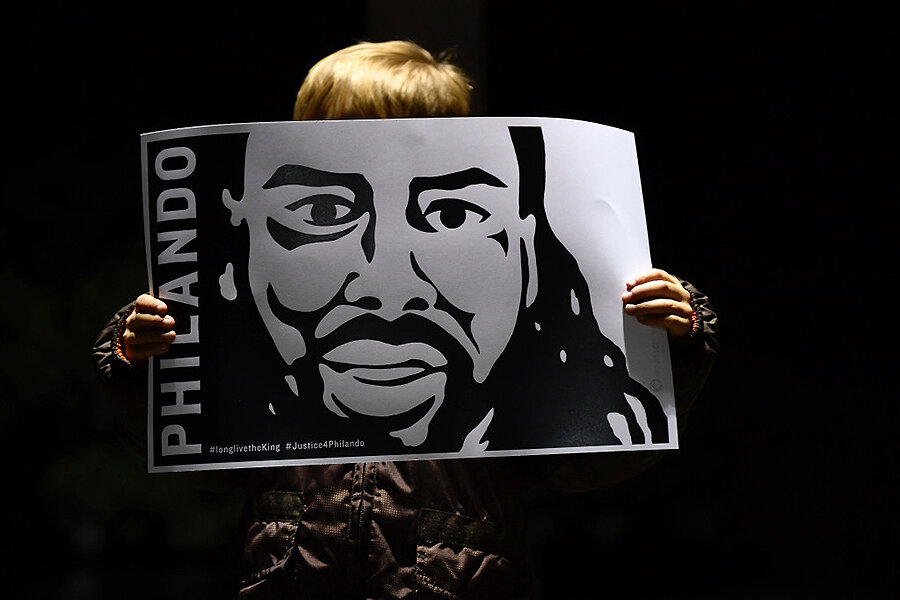Did video prevail? Officer charged in Philando Castile shooting
Loading...
Ramsey County prosecutors have charged a Minnesota police officer in the fatal shooting of Philando Castile, whose death last summer sparked a wave of protests, while underscoring technology's newfound importance for activists protesting police violence.
On July 6, St. Anthony police officer Jeronimo Yanez pulled over Mr. Castile, a black motorist, during a traffic stop. Just a few moments later, Mr. Yanez fired seven shots at Castile, killing him. The immediate aftermath of the shooting, which was streamed on Facebook Live by Castile's girlfriend, Diamond Reynolds, sparked protests and highlighted ongoing tensions between minority communities and the police.
On Wednesday, Ramsey County Attorney John Choi told reporters that Yanez had been charged with second-degree manslaughter.
"The family is pleased with that recommendation because we know what type of charges could be brought about by the statutes of Minnesota laws," Castile's mother, Valerie Castile, told reporters. "We're here in solidarity, my family and I, to support that decision."
The officer had pulled Castile over for a broken tail light, and suspicion of involvement in a robbery; however, Castile had no involvement, Mr. Choi said. After being stopped, Castile told the officer that he was legally carrying a firearm. Yanez repeatedly told Castile not to reach for the weapon, while Castile and Ms. Reynolds replied that he was not. A second officer at the scene said he did not see Castile make any sudden movements.
A few moments later, Yanez drew his gun and fired seven shots at Castile. About 40 seconds after the shooting, Ms. Reynolds began streaming from the passenger seat. The subsequent recording went viral on social media.
Paramedics and officers later found a handgun in Castile's right front pocket. The gun had a loaded magazine, but no round in the chamber. Castile's wallet contained both a driver’s license and his permit to carry.
"I cannot allow the death of a motorist who was lawfully carrying a firearm under these facts and circumstances to go unaccounted for," Choi said.
Since 2000, there have been more than 150 police-involved deaths in Minnesota, but no on-duty officers were charged in any of those cases, according to the Minneapolis Star Tribune. In addition to the manslaughter charge, Yanez was also charged with two counts of intentionally discharging a firearm that endangers the safety of others – one count for Reynolds, and another for her daughter, who was present in the back seat. If convicted on all three counts, Yanez could face up to 20 years in prison.
"Without my recording," Reynolds said, "we wouldn't be here today."
The shooting, and the video that documented it, highlighted the deep sense of vulnerability many black Americans feel around the police, as well as the growing role of technology in social activism.
"It's the first live-streamed police murder, and it speaks to some kind of watershed," George Ciccariello-Maher, a political scientist at Drexel University, told the Monitor soon after Castile's death. "[Reynolds's] description is a stunning moment: She knows it's an injustice, and she knows that there's an audience for this injustice – that there is an echo when you cry out in the wilderness."
More than ever before, cellphone videos are seen as a powerful tool of empowerment for black communities protesting what many allege is a persistent history of racial bias in the use of police force. At the time of Castile's death, 24 percent of the 509 people shot and killed by police so far in 2016 were black, although black people make up 13 percent of the US population.
Reynolds's immediate impulse to document and narrate Castile's death, some experts say, underscores technology's new role in that push for justice, now brought into national focus after the high-profile, police-involved deaths of numerous black men in recent years.
In post-Ferguson America, the legal outcomes of police shootings have been mixed. Recent cases in South Carolina, Illinois, and Ohio have resulted in murder charges for law enforcement officials. Grand juries in Ferguson and New York, however, declined to indict officers involved in the killing of unarmed men. But even in those cases, social media has played a powerful role in awareness and accountability.
"Black Americans might never be able to have the last word on these issues," Robert Ruffins, a community organizer in New Orleans, told the Monitor last July, "but social media has at times given us the ability to have the first word – the ability to tell your story and to make it real."
This report includes material from Reuters and The Associated Press.






